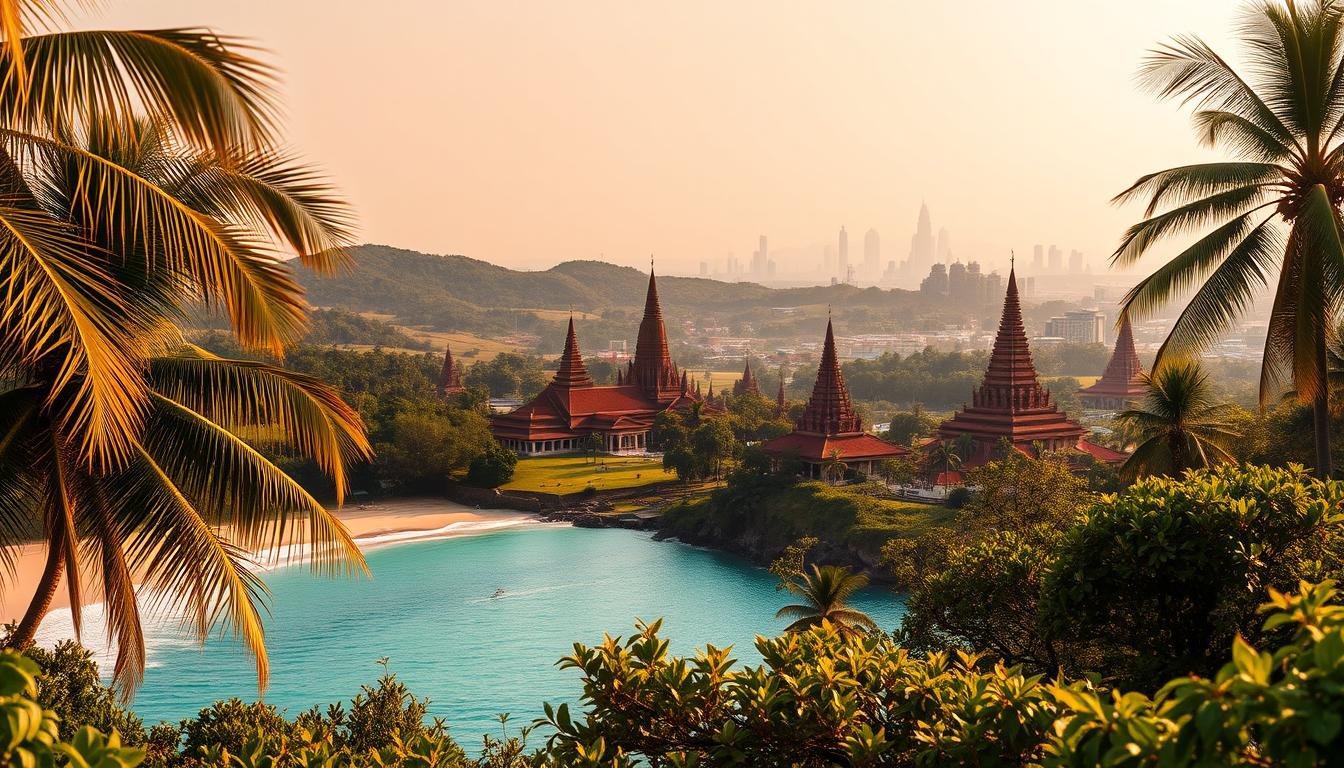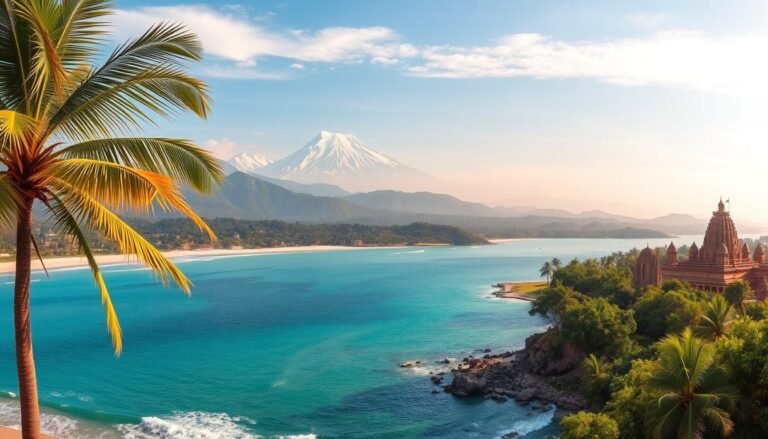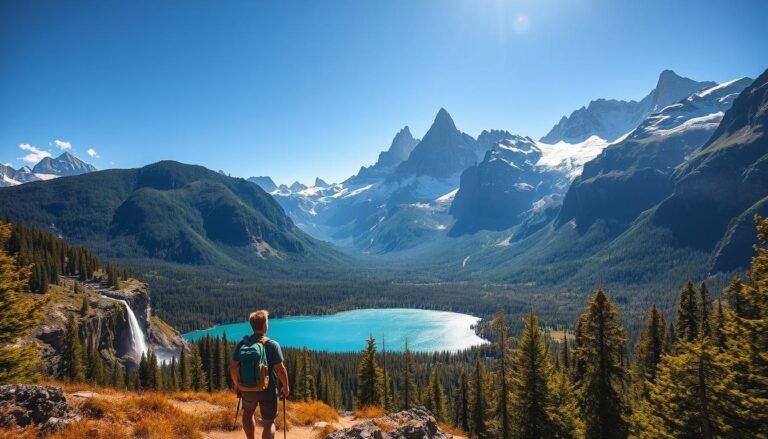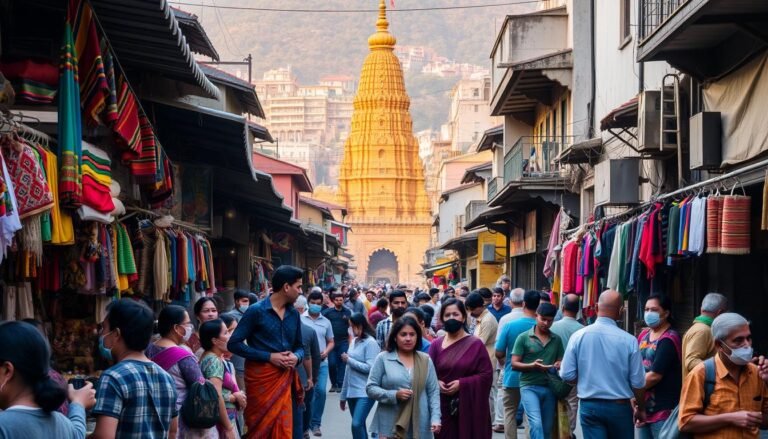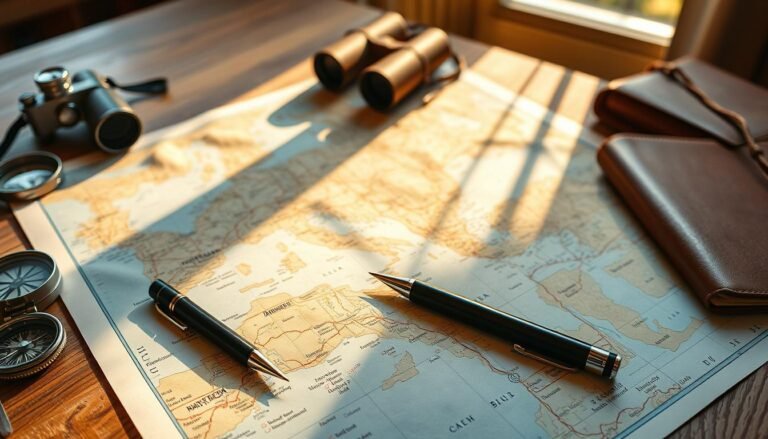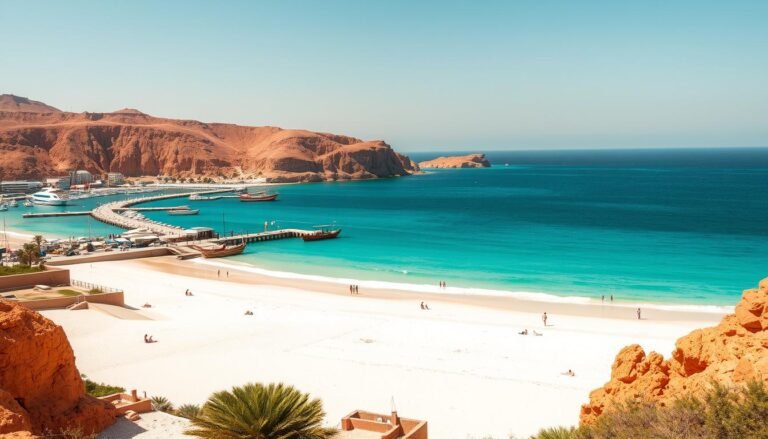Unforgettable Experiences: Travel to Southeast Asia
Travel to south east asia: Discover why this region has become one of the world’s most sought-after travel destinations, offering everything from ancient temples to pristine beaches and vibrant cities.
With its affordable accommodations, transportation, and dining options, Southeast Asia makes for an accessible trip for various budgets, promising a journey of a lifetime.
Why Southeast Asia Should Be Your Next Adventure
Southeast Asia beckons travelers with its rich tapestry of cultures, breathtaking landscapes, and vibrant cities. This region, comprising countries such as Thailand, Vietnam, Cambodia, and Indonesia, offers a diverse array of experiences that cater to all kinds of travelers.
The Allure of Southeast Asia
The allure of Southeast Asia lies in its unique blend of natural beauty, cultural heritage, and modern attractions. From the pristine beaches of Bali to the ancient temples of Angkor Wat, the region is replete with breathtaking landscapes and historical landmarks. The extraordinary biodiversity found throughout Southeast Asia, from orangutans in Borneo to komodo dragons in Indonesia and elephants in Thailand, is a major draw for nature lovers and wildlife enthusiasts.
The region’s remarkable culinary diversity is another significant attraction, with each country offering distinctive flavors and cooking techniques that have influenced food culture worldwide. The strategic location of Southeast Asia at the crossroads of major civilizations has created a fascinating blend of influences from China, India, the Middle East, and Europe, making it a melting pot of people and traditions.
What Makes Southeast Asia Unique
Southeast Asia stands out due to its complex history, which has been shaped by colonial past, religious influences, and indigenous traditions. This blend has resulted in a rich culture that is unique to each country in the region. The people of Southeast Asia are known for their hospitality and warmth towards visitors, making travelers feel welcome in this part of the world.
As noted by a travel expert, “The beauty of Southeast Asia lies not just in its landscapes or historical sites, but in the resilience and spirit of its people.” This sentiment is echoed by the numerous cultural festivals and traditions that take place throughout the year, showcasing the region’s vibrant heritage.
The unique cultural identity of Southeast Asia is further reflected in its numerous temples, festivals, and traditional practices. For instance, the water festivals in Thailand and Cambodia, the temple ceremonies in Chiang Mai, and the traditional dances in Bali are just a few examples of the region’s rich cultural tapestry.
Best Time to Travel to South East Asia
Planning a trip to Southeast Asia requires understanding the region’s diverse climate to make the most of your travel experience. The timing of your visit can significantly impact your enjoyment of the region’s beautiful landscapes, cultural events, and outdoor activities.
Seasonal Considerations
Southeast Asia is characterized by a tropical climate with variations in temperature and precipitation throughout the year. Generally, the region experiences a dry season and a wet season, with the dry season being the most popular time for tourists. The dry season typically runs from November to April, offering pleasant weather conditions ideal for exploring cities, enjoying beaches, and participating in outdoor activities.
The wet season, which varies by country, often brings lush green landscapes and fewer tourists, making it an attractive time for those looking for a more serene experience. However, the heavy rains can sometimes disrupt travel plans.
Country-Specific Weather Patterns
Understanding the specific weather patterns of each country in Southeast Asia is crucial for planning your trip.
- Thailand: Thailand has three distinct seasons. The cool season from November to February is the best time to visit, offering pleasant conditions for exploring both the northern mountains and southern beaches.
- Vietnam: Vietnam’s climate varies significantly from north to south. The north experiences a cooler winter, while the south remains tropical year-round. Planning your visit according to these climate zones can enhance your travel experience.
- Cambodia: Cambodia has a tropical climate with a wet and dry season. The best time to visit is from November to March, avoiding the intense heat of April and the heavy rains of September.
- Laos: Laos experiences a distinct wet and dry season. The dry season from November to April is the most comfortable time for exploring this mountainous country.
- Malaysia, Indonesia, and the Philippines: These countries have complex monsoon patterns, with different parts experiencing opposite weather conditions. Understanding these patterns is key to planning your trip.
By considering these country-specific weather patterns, you can tailor your trip to make the most of your time in Southeast Asia, ensuring a memorable and enjoyable travel experience.
Essential Destinations in Southeast Asia
From bustling metropolises to serene beaches, Southeast Asia offers a myriad of unforgettable experiences for every kind of traveler. This region is a melting pot of cultures, histories, and landscapes, making it a fascinating area to explore.
Thailand’s Must-Visit Locations
Thailand is a country that seamlessly blends tradition with modernity. Bangkok, the capital, is known for its vibrant street life, ornate temples, and bustling markets. Chiang Mai, in the north, is a cultural hub with numerous temples and a thriving arts scene. The southern islands, such as Phuket and Koh Samui, offer stunning beaches and crystal-clear waters.
- Explore Bangkok’s Grand Palace and Wat Phra Kaew.
- Visit Chiang Mai’s Doi Suthep for panoramic views.
- Relax on Phuket’s Patong Beach.
Vietnam’s Hidden Gems
Vietnam is a country of contrasts, from the bustling streets of Hanoi to the serene beauty of Ha Long Bay. Beyond the popular destinations, Vietnam has many hidden gems. Ha Giang is known for its stunning mountain scenery and trekking opportunities. Ninh Binh offers a more relaxed pace, with its picturesque countryside and ancient temples.
| Destination | Main Attraction |
|---|---|
| Ha Giang | Mountain trekking |
| Ninh Binh | Ancient temples and countryside |
| Con Dao Islands | Pristine beaches and historical sites |
Cambodia’s Cultural Treasures
Cambodia is home to some of Southeast Asia’s most impressive cultural heritage sites. Angkor Wat, near Siem Reap, is one of the largest temple complexes in the world and a testament to Khmer architecture. The capital, Phnom Penh, offers insights into the country’s history, with landmarks like the Royal Palace and the National Museum.
“Angkor Wat is a magnificent representation of Khmer art and architecture, reflecting the spiritual and cultural values of the Cambodian people.”
Laos and Other Emerging Destinations
Luang Prabang in Laos is a UNESCO World Heritage site, known for its well-preserved architecture, vibrant night market, and spiritual significance. Vang Vieng has transformed into an adventure sports hub, offering activities like kayaking and hot air ballooning. The capital, Vientiane, provides a laid-back atmosphere, perfect for unwinding.
Emerging destinations in Southeast Asia include Myanmar’s ancient temples, the Philippines’ perfect beaches, and Borneo’s wildlife-rich rainforests. These countries offer authentic experiences and are contributing to the region’s expanding tourism map.
- Discover Luang Prabang’s UNESCO World Heritage architecture.
- Experience Vang Vieng’s adventure sports.
- Explore the emerging destinations in Myanmar, the Philippines, and Borneo.
Island Paradise: Beaches and Coastal Getaways
From Thailand’s southern islands to Cambodia’s hidden gems, Southeast Asia’s coastal regions are a treasure trove of unforgettable experiences. The region’s diverse island landscapes offer a mix of bustling beach towns, secluded coves, and idyllic beaches that cater to every kind of traveler.
Koh Phi Phi and Thailand’s Southern Islands
Koh Phi Phi, part of Thailand’s southern islands, is renowned for its stunning beaches and vibrant marine life. The island’s turquoise waters and dramatic limestone cliffs make it a perfect spot for snorkeling and diving.
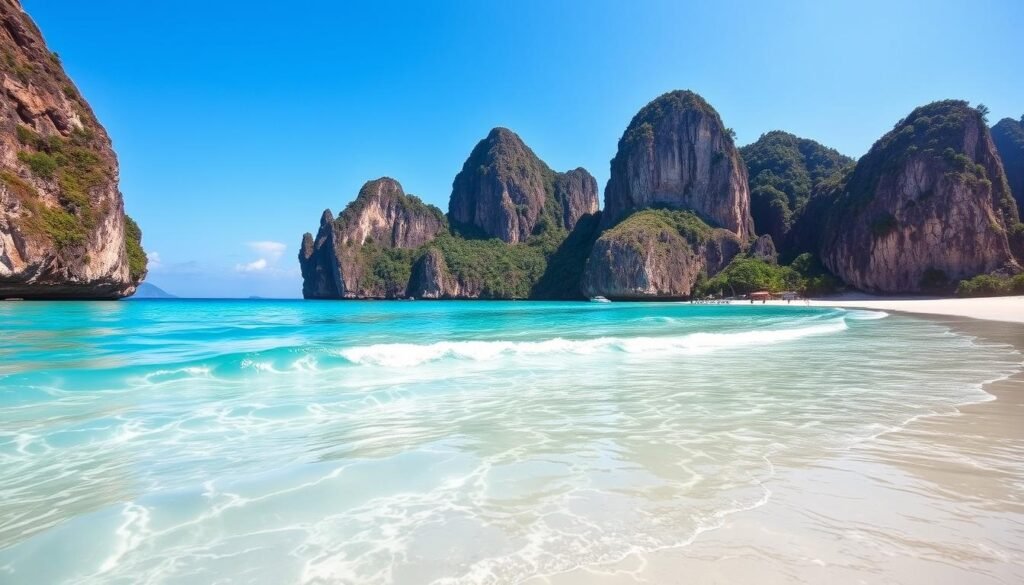
Vietnam’s Coastal Retreats
Vietnam’s coastline is dotted with charming coastal towns and secluded beaches, offering a serene escape from the hustle and bustle of city life. Places like Nha Trang and Da Nang are popular for their beautiful beaches and water sports.
Island Koh Rong: Cambodia’s Beach Haven
Koh Rong, off the coast of Cambodia, is a tropical paradise with pristine beaches and crystal-clear waters. It’s an ideal destination for those seeking a tranquil island getaway, with opportunities for snorkeling, diving, and simply relaxing on the beach.
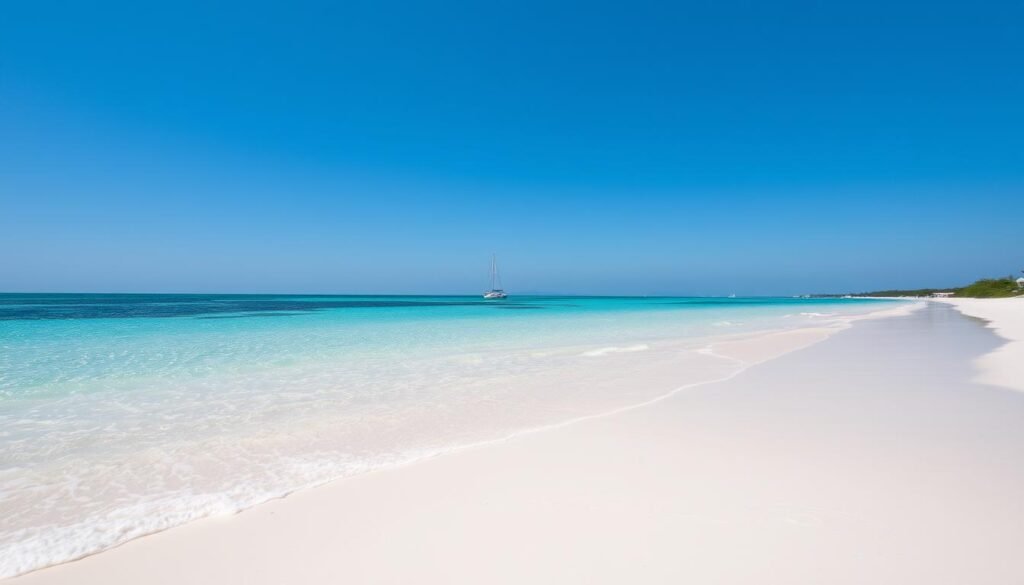
Philippines’ Island Escapes
The Philippines, with its over 7,000 islands, is a haven for beach lovers and adventure seekers. Destinations like Palawan, Boracay, and Siargao offer some of Southeast Asia’s most spectacular beaches, diving opportunities, and surfing experiences.
Palawan’s limestone landscapes, particularly around El Nido and Coron, reveal hidden lagoons and perfect beaches through island-hopping tours. Boracay, despite stricter regulations following environmental challenges, continues to attract visitors with its white sand and clear waters. Siargao has emerged as Southeast Asia’s surfing capital, with waves for both beginners and experts, and a laid-back island vibe.
Cultural Immersion: Temples and Historical Sites
Immerse yourself in the cultural richness of Southeast Asia by visiting its iconic temples and historical sites. This region is home to a diverse array of cultural and historical landmarks that offer a glimpse into its rich heritage.
Angkor Wat: Cambodia’s Crown Jewel
Angkor Wat, located in Siem Reap, Cambodia, is one of the largest and most impressive temple complexes in the world. This ancient wonder is a testament to Khmer architecture and artistry.
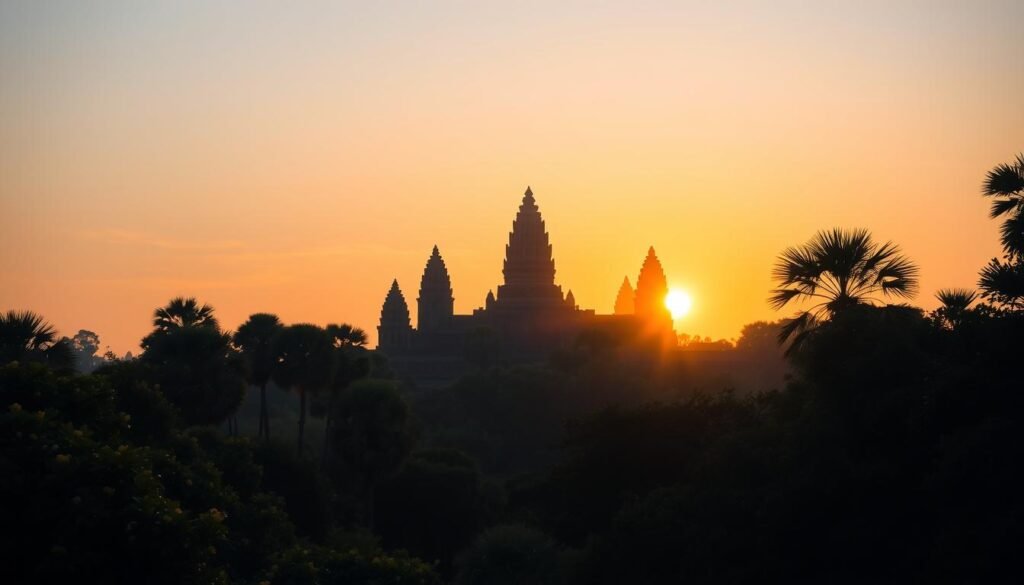
Explore the intricate carvings, imposing structures, and the historical significance that make Angkor Wat a must-visit destination.
Chiang Mai’s Temple Circuit
Chiang Mai, Thailand, is renowned for its numerous temples, each offering a unique glimpse into the region’s spiritual practices and cultural heritage. Doi Suthep, with its golden chedi, is a highlight, providing panoramic views of the city.
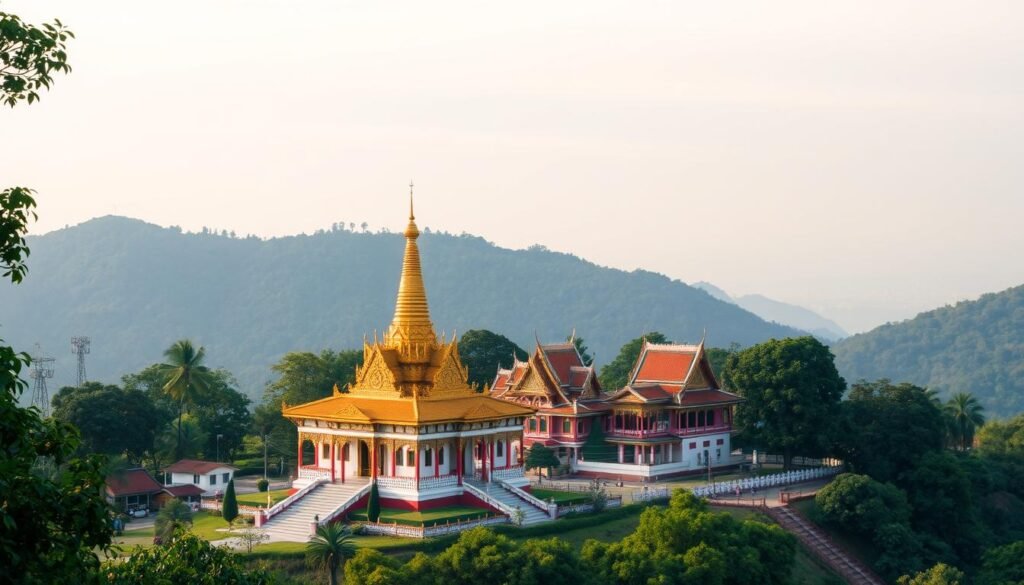
The city’s temple circuit is a journey through spirituality and art, showcasing the rich cultural tapestry of Chiang Mai.
Vietnam’s Historical Landmarks
Vietnam is dotted with historical landmarks that reflect its complex history and cultural influences. From the ancient town of Hoi An to the imperial city of Hue, each site offers a unique perspective on Vietnam’s past.
These landmarks are not only significant culturally but also offer insights into Vietnam’s resilience and heritage.
Luang Prabang’s Sacred Sites
Luang Prabang, Laos, is a city that seamlessly blends traditional Lao and French colonial architecture, earning it a UNESCO World Heritage designation. The city’s sacred sites, including Wat Xieng Thong and Mount Phousi, are integral to its cultural identity.
- Discover why UNESCO designated the entire historic center of Luang Prabang a World Heritage site, preserving its unique blend of traditional Lao and French colonial architecture.
- Learn about Wat Xieng Thong, Luang Prabang’s most magnificent temple, with its sweeping roofs, intricate mosaics, and significance as the site of royal coronations.
- Understand the spiritual importance of Mount Phousi, the sacred hill in the center of town crowned by That Chomsi stupa, which offers panoramic views and spiritual significance.
- Explore the Royal Palace Museum (Haw Kham) to understand Laos’ royal history and see the Phra Bang Buddha image that gave the city its name.
- Discover how to respectfully observe the daily morning alms-giving ceremony (tak bat), where hundreds of monks collect their daily food from local residents and visitors.
The city’s sacred sites are a testament to its rich cultural heritage and spiritual practices, making Luang Prabang a unique cultural destination.
Southeast Asia Itineraries for Every Timeline
Whether you’re a seasoned traveler or just starting to plan your adventure, Southeast Asia offers a diverse array of experiences tailored to every timeline. The region’s rich cultural heritage, stunning landscapes, and vibrant cities make it an ideal destination for travelers with varying interests and time constraints.
Two-Week Whirlwind Tour
For those with limited time, a two-week itinerary can still offer a taste of Southeast Asia’s diversity. Focus on one or two countries to avoid excessive travel time. For instance, explore Thailand’s bustling Bangkok, the ancient city of Chiang Mai, and the beautiful islands of Phuket or Koh Samui. Alternatively, visit Vietnam’s Hanoi, explore the scenic Ha Long Bay, and experience the vibrant city of Ho Chi Minh.
- Day 1-3: Explore Bangkok and Chiang Mai in Thailand.
- Day 4-7: Relax on Phuket or Koh Samui.
- Day 8-14: Continue to Hanoi, Vietnam, and explore Ha Long Bay and Ho Chi Minh City.
One-Month Comprehensive Journey
With a month at your disposal, you can delve deeper into Southeast Asia. This timeline allows you to visit multiple countries and experience the region’s varied cultures and landscapes. A suggested itinerary could include Thailand, Cambodia, and Vietnam. Spend your days exploring ancient temples, enjoying local cuisine, and relaxing on beautiful beaches.
- Week 1: Discover Thailand’s culture and cuisine.
- Week 2: Visit Cambodia’s Angkor Wat and enjoy the nightlife in Siem Reap.
- Week 3: Explore Vietnam’s history and natural beauty.
- Week 4: Relax on the beaches of Thailand or Vietnam.
Three-Month Deep Dive
A three-month journey allows for a deep dive into the heart of Southeast Asia. You can adopt a slow travel approach, spending weeks in one location, immersing yourself in local cultures, and perhaps even learning a new language or skill. This timeline is ideal for volunteering, studying, or working remotely in destinations like Chiang Mai, Thailand, or Siem Reap, Cambodia.
- Spend a month in Thailand, exploring different regions.
- Volunteer or study in Cambodia for a few weeks.
- Experience Vietnam’s diverse landscapes and cultures.
Six-Month+ Extended Adventure
For the true adventurers, a six-month or longer stay in Southeast Asia transforms the experience into a journey of discovery. You can visit every country in the region, adopting a lifestyle that blends travel with local living. This extended timeline opens up opportunities for in-depth exploration, cultural immersion, and even working or studying in various countries.
- Explore the entire region, from Malaysia to Indonesia and the Philippines.
- Consider visa implications and plan border runs or extensions accordingly.
- Follow seasonal changes to make the most of your journey.
Transportation Guide: Getting Around Southeast Asia
Getting around Southeast Asia is an adventure in itself, with various transportation modes connecting its vibrant cities and serene landscapes. Whether you’re traveling between countries or exploring local destinations, understanding the transportation options is key to a smooth journey.
International and Regional Flights
Southeast Asia is well-connected by air, with numerous international and regional airports serving major cities. Budget airlines have made flying affordable, with carriers like AirAsia, Scoot, and VietJet offering competitive prices on short-haul flights. When planning your trip, consider booking flights in advance to secure the best deals.
| Airline | Route | Average Price |
|---|---|---|
| AirAsia | Bangkok – Kuala Lumpur | $50 |
| Scoot | Singapore – Tokyo | $100 |
| VietJet | Ho Chi Minh City – Hanoi | $30 |
Land Transportation Options
For land travel, Southeast Asia offers a range of options, including buses, trains, and taxis. Bus services are extensive, with companies like Green Bus in Thailand and Phuong Trang in Vietnam providing comfortable and affordable rides between cities. Trains are another convenient option, with Vietnam’s Reunification Express and Thailand’s Eastern & Oriental Express offering scenic routes.
- Bus services connect major cities and towns, often with modern amenities.
- Trains offer a more leisurely pace, with some routes featuring sleeper cars for overnight journeys.
- Taxis and ride-hailing services are widely available in urban areas.
Water Travel: Ferries and Boats
Exploring Southeast Asia’s island destinations often involves boat travel. Ferry networks are extensive, connecting mainland destinations to island paradises throughout Thailand, Malaysia, Indonesia, and the Philippines. When choosing a boat service, consider factors like comfort, speed, and authenticity. From high-speed catamarans to traditional wooden boats cruising along scenic waterways, there’s a boat to suit every preference.
Iconic boat journeys, such as the slow boat down the Mekong River from Thailand to Luang Prabang, offer a unique perspective on the region’s landscapes and river life. When engaging in water travel, it’s essential to consider safety aspects, such as checking for life jackets and avoiding overcrowded vessels.
Accommodation Options for Every Budget
From budget-friendly hostels to luxury resorts, Southeast Asia’s accommodation landscape is as varied as it is vibrant. Travelers can choose from a wide range of options to suit their needs and budget.
Hostels and Budget Stays
For the budget-conscious traveler, Southeast Asia offers a plethora of affordable accommodation options. Hostels and guesthouses are abundant, providing basic amenities at affordable prices.
- Dorm rooms and shared facilities for the social traveler
- Private rooms for those seeking more solitude
- Basic amenities, such as free Wi-Fi and communal kitchens
Mid-Range Hotels and Guesthouses
For those seeking a balance between affordability and comfort, mid-range hotels and guesthouses are an excellent choice. These establishments offer a higher level of service and amenities, such as en-suite bathrooms and on-site restaurants.
Some popular mid-range options include:
- Family-run guesthouses with personalized service
- Boutique hotels with stylish decor and modern amenities
- Hotels with swimming pools and on-site dining
Luxury Resorts and Unique Stays
Southeast Asia has become a hotspot for luxury travel, with world-class resorts offering exceptional service at competitive prices. Iconic luxury brands, such as Aman, Six Senses, and Four Seasons, have multiple properties throughout the region.
Some unique luxury experiences include:
- Overwater bungalows in Malaysia and Thailand
- Treetop villas in Laos and Cambodia
- Restored royal residences in Cambodia and Indonesia
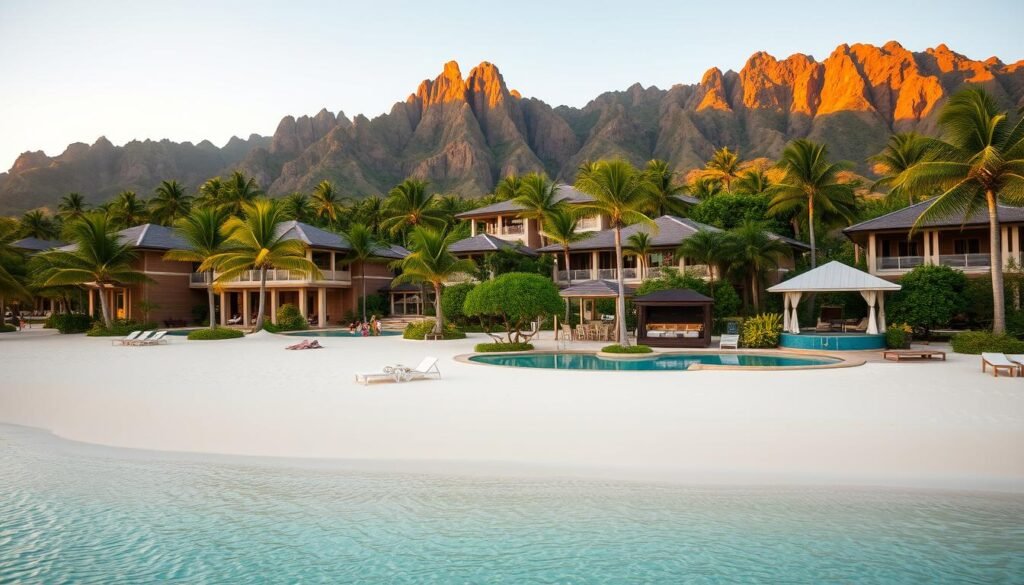
| Location | Luxury Brand | Unique Feature |
|---|---|---|
| Thailand | Aman | Private villas with personal pools |
| Cambodia | Six Senses | Treetop villas with stunning views |
| Indonesia | Four Seasons | Private beach access and villas |
Culinary Journey Through Southeast Asia
Embarking on a culinary journey through Southeast Asia is an adventure that promises to tantalize your taste buds and broaden your gastronomic horizons. The region’s diverse culinary landscape is shaped by its rich cultural heritage, geographical variety, and the warm hospitality of its people.
Street Food Adventures
Street food is an integral part of Southeast Asia’s culinary identity, offering a wide array of dishes that are both affordable and delicious. From Thailand’s spicy tom yum soup to Vietnam’s fresh spring rolls, the region’s street food scene is a reflection of its cultural diversity. Visiting local markets is a great way to experience the sights, sounds, and flavors of Southeast Asia’s street food.
In cities like Bangkok and Hanoi, street food stalls and night markets serve as culinary hubs where locals and tourists alike gather to enjoy a variety of dishes. The aromas, flavors, and communal atmosphere of these markets make for an unforgettable dining experience.
Regional Specialties You Must Try
Southeast Asia is home to a diverse range of regional specialties that showcase the unique flavors and ingredients of each country. In Thailand, dishes like pad thai and green curry are must-try’s, while in Vietnam, pho and banh mi are popular choices. Cambodia’s fish amok and Laos’ larb are other examples of the region’s rich culinary diversity.
| Country | Must-Try Dish | Description |
|---|---|---|
| Thailand | Pad Thai | Stir-fried noodles with shrimp, tofu, and peanuts |
| Vietnam | Pho | Beef noodle soup with herbs and spices |
| Cambodia | Fish Amok | Steamed fish in coconut milk curry |
Dining Etiquette and Tips
When dining in Southeast Asia, it’s essential to be mindful of local customs and etiquette. In many countries, including Thailand and Cambodia, it’s customary to use chopsticks, while in Vietnam, a combination of chopsticks and a spoon is common. In some regions, eating with your hands is also acceptable.
- Learn basic phrases in local languages to enhance your dining experience.
- Be respectful of cultural norms, such as not finishing a meal completely, which can imply that the host did not provide enough food.
- Understand tipping practices, which vary across the region.
Adventure Activities and Outdoor Experiences
Southeast Asia is a haven for adventure seekers, offering a diverse range of outdoor experiences that cater to all levels of thrill and exploration. From trekking through lush forests to diving in crystal-clear waters, the region is a playground for outdoor enthusiasts.
Trekking and Hiking Opportunities
Southeast Asia boasts some of the most spectacular trekking routes in the world. In Thailand, particularly around Chiang Mai, trekkers can explore the hills of northern Thailand, visiting remote villages and enjoying breathtaking scenery. The region offers tour options for all levels, from easy day hikes to challenging multi-day treks.
For the more adventurous, Vietnam’s Sapa region offers trekking through rice paddies and hill tribes, while Cambodia’s Cardamom Mountains provide a more rugged and less traveled path.
Water Sports and Marine Activities
The waters of Southeast Asia offer a myriad of opportunities for water sports and marine activities. From snorkeling and diving in the Philippines’ coral reefs to kayaking through Indonesia’s mangrove forests, there’s something for every water lover. The region’s beautiful beaches and islands, such as those in Thailand and Vietnam, provide the perfect backdrop for these activities.
For those looking for a more leisurely experience, boat option are available, offering tours to explore the region’s stunning coastlines and marine life.
Wildlife Encounters
Southeast Asia is home to a diverse range of wildlife, and there are many opportunities for people to engage in responsible wildlife viewing. Ethical elephant experiences in Thailand, particularly around Chiang Mai, have shifted from riding to observation, feeding, and bathing in more natural environments.
Visitors can also explore marine wildlife encounters, such as swimming with whale sharks in the Philippines, participating in turtle conservation projects in Malaysia, and ethical dolphin watching in Indonesia. It’s essential to choose tour operators that genuinely protect animals rather than exploiting them.
Off the Beaten Path: Hidden Gems in Southeast Asia
Southeast Asia is home to numerous hidden gems that are waiting to be discovered by intrepid travelers. While popular destinations like Bali and Phuket attract millions of visitors each year, there are many other locations in the region that offer equally compelling experiences without the crowds.
Lesser-Known Islands and Beaches
For beach lovers, Southeast Asia has much more to offer beyond its famous resorts. Myanmar’s Ngapali Beach is a tranquil retreat with pristine sands and crystal-clear waters. Similarly, the Siargao Island in the Philippines is gaining popularity for its surfing and laid-back atmosphere. These lesser-known islands and beaches provide a serene escape from the more crowded tourist spots.
- Discover secluded coves and untouched beaches in Malaysia’s Perhentian Islands.
- Explore the idyllic landscapes of Indonesia’s Maluku Islands.
Remote Villages and Cultural Experiences
Southeast Asia is not just about beaches; it’s also home to numerous remote villages that offer rich cultural experiences. Inle Lake in Myanmar is famous for its traditional leg-rowing fishermen and floating villages. Visitors can also explore the 4000 Islands region in southern Laos, where the Mekong River creates a vast, laid-back archipelago perfect for a digital detox and authentic river life.
- Visit the traditional villages of Borneo’s Sabah and Sarawak in Malaysia to experience indigenous cultures.
- Explore the rice terraces of Banaue in the Philippines, a testament to the region’s agricultural heritage.
Emerging Destinations Worth Visiting
As climate change, political developments, and infrastructure improvements continue to shape the region, new destinations are emerging that may become tomorrow’s hotspots. Travelers can explore the temple plains of Bagan in Myanmar or visit the chocolate hills of Bohol in the Philippines. These emerging destinations offer a fresh perspective on Southeast Asia and its diverse attractions.
- Understand the impact of climate change on Southeast Asia’s tourism and local communities.
- Learn about the cultural heritage of Cambodia’s lesser-known temples and historical sites.
In conclusion, Southeast Asia is a region that is full of surprises, offering countless opportunities for exploration and discovery. By venturing off the beaten path, travelers can experience the authentic charm of this diverse and vibrant region.
Navigating Markets and Shopping Experiences
From bustling night markets to serene local bazaars, Southeast Asia’s shopping experiences are as diverse as they are captivating. The region’s markets are a reflection of its rich cultural heritage, offering a blend of traditional handicrafts, local cuisine, and unique souvenirs.
Night Markets Not to Miss
Southeast Asia is renowned for its night markets, where the air is filled with the aroma of street food, and the stalls are laden with everything from clothing to handicrafts. Some of the must-visit night markets include Bangkok’s Rot Fai Market, Hanoi’s Old Quarter Night Market, and Chiang Mai’s Walking Street. These markets offer a glimpse into local life and are perfect places to pick up unique souvenirs.
- Discover a variety of local street food, from spicy skewers to sweet desserts.
- Shop for handmade crafts, clothing, and accessories at bargain prices.
- Enjoy the lively atmosphere, often accompanied by live music or performances.
Souvenirs and Handicrafts
When it comes to souvenirs, Southeast Asia is a treasure trove of traditional handicrafts. Visitors can find a wide range of items, including intricate textiles, delicate ceramics, and beautifully crafted woodcarvings. To ensure you’re purchasing authentic, locally-made handicrafts, look for the following:
| Country | Signature Craft | What to Look For |
|---|---|---|
| Thailand | Celadon Pottery | Intricate designs, high-quality ceramic finish |
| Laos | Intricate Textiles | Vibrant colors, traditional Lao motifs |
| Cambodia | Silver Betelnut Boxes | Intricate silverwork, often featuring traditional Khmer designs |
| Vietnam | Lacquerware | High-gloss finish, often decorated with mother-of-pearl |
By shopping at local markets and choosing authentic handicrafts, you’re not only taking home a piece of Southeast Asia but also supporting local artisans and contributing to the preservation of traditional crafts.
Planning Your Travel to South East Asia
Planning a trip to Southeast Asia requires careful consideration of several key factors to ensure a memorable and stress-free experience. As you prepare for your journey, there are several essential aspects to address, from visa requirements to travel insurance.
Visa Requirements and Documentation
Understanding the visa requirements for Southeast Asia is a critical first step in planning your trip. Different countries in the region have varying visa policies, with some allowing visa-free entry for certain nationalities, while others require obtaining a visa in advance or upon arrival. For instance, countries like Thailand and Vietnam offer visa exemptions for tourists from certain countries for a limited period, while Cambodia and Laos may require a visa on arrival or an e-visa.
It’s essential to check the specific visa requirements for each country on your itinerary well in advance. Ensuring your passport is valid for at least six months beyond your planned departure date from the countries you visit is also crucial. Additionally, having photocopies of your passport, visa, and travel insurance documents, and leaving a copy with a trusted friend or family member back home, can be helpful in case of an emergency.
Health Preparations and Vaccinations
Health preparations are a vital part of planning your trip to Southeast Asia. Consult your healthcare provider or a travel clinic to determine the necessary vaccinations and medications for travel to the region. Common recommendations include vaccinations against hepatitis A, typhoid, and rabies, as well as ensuring your routine vaccinations are up to date.
Depending on your travel plans, additional precautions may be necessary, such as malaria prophylaxis if you’re visiting rural areas where the disease is prevalent. Don’t forget to pack any personal medications, along with a copy of your prescription and a letter explaining your medical condition, if applicable.
Budgeting and Money Matters
Southeast Asia can be a very affordable destination, but budgeting is still essential to make the most of your trip. The local currency varies across countries, so it’s a good idea to have some local cash upon arrival for initial expenses. Credit cards are widely accepted in tourist areas, but having some cash for smaller purchases or at local markets is advisable.
Informing your bank of your travel plans can prevent your card from being flagged for suspicious activity. Consider using a money belt or a secure wallet to protect your valuables, especially in crowded places. Budgeting for meals, accommodations, and activities in advance can help you stick to your financial plan and enjoy your trip without financial stress.
Travel Insurance and Safety Considerations
Travel insurance is a crucial aspect of trip planning, providing coverage for unexpected medical emergencies, trip cancellations, or interruptions. When selecting a travel insurance policy for Southeast Asia, consider the types of activities you plan to engage in. For instance, if you plan to go diving, motorbiking, or trekking, ensure your policy covers these activities, as some may be considered high-risk and require additional coverage.
Safety considerations are also paramount. Stay informed about local conditions, respect local customs, and be aware of your surroundings. In case of emergencies, knowing the contact information for your embassy, local emergency services, and having access to international medical facilities can be invaluable.
“The journey of a thousand miles begins with a single step.” – Lao Tzu
This ancient wisdom reminds us that preparation is key to a successful journey.
By carefully planning your trip to Southeast Asia, including visa requirements, health preparations, budgeting, and travel insurance, you can ensure a safe and enjoyable journey through this vibrant region.
Packing Essentials for Southeast Asia
Packing for Southeast Asia requires a thoughtful approach, considering the region’s diverse climates and activities. Whether you’re island-hopping in Thailand, trekking through Vietnam, or exploring the temples of Cambodia, being prepared is key to a stress-free and enjoyable travel experience.
Clothing and Footwear
When it comes to clothing, the humid tropical climate of Southeast Asia calls for lightweight, breathable fabrics. Quick-drying shirts, convertible pants, and a lightweight rain jacket are essentials. For footwear, sturdy sandals or hiking boots are a must for water activities and trekking adventures. Don’t forget to pack comfortable walking shoes for city explorations.
| Clothing Item | Recommended For |
|---|---|
| Lightweight shirts | Daily wear, temple visits |
| Convertible pants | Hiking, city exploration |
| Swimwear | Beach and water activities |
Tech and Travel Gadgets
In today’s digital age, travel gadgets can greatly enhance your experience. A portable charger is indispensable for long flights and days out. Consider packing a waterproof phone case for water activities and a travel adapter for keeping your devices charged across different countries.
- Portable charger for extra power on the go
- Waterproof phone case for protection
- Travel adapter for charging in different outlets
Health and Hygiene Items
Maintaining health and hygiene is crucial when traveling to Southeast Asia. Pack a basic first aid kit with essentials like band-aids, antiseptic wipes, and pain relievers. Don’t forget prescription medications and consider eco-friendly alternatives to single-use plastics, such as water purification tablets, to reduce your environmental footprint.
- First aid kit with essentials
- Prescription medications and personal care items
- Eco-friendly water purification options
By thoughtfully packing these essentials, you’ll be well-prepared for the adventures that await you in Southeast Asia, from bustling cities to serene beaches and beyond.
Responsible Tourism in Southeast Asia
As travelers increasingly explore Southeast Asia, adopting responsible tourism practices becomes crucial for preserving the region’s natural beauty and cultural heritage. This approach not only enhances the travel experience but also contributes to the well-being of local communities and the environment.
Environmental Considerations
Tourism can have a significant impact on Southeast Asia’s diverse ecosystems. To mitigate this, travelers can take several steps:
- Reduce plastic use by carrying reusable bags and water bottles.
- Choose eco-friendly accommodations and tour operators.
- Respect wildlife and their habitats, avoiding activities that harm or exploit animals.
| Environmental Impact | Responsible Action |
|---|---|
| Plastic Pollution | Use reusable bags and water bottles |
| Habitat Destruction | Choose eco-friendly tour operators |
| Wildlife Exploitation | Avoid activities that harm animals |
Supporting Local Communities
Supporting local economies is a vital aspect of responsible tourism. Travelers can make a positive impact by:
- Eating at local restaurants and street food stalls.
- Shopping at local markets and from local artisans.
- Using local transportation services.
By doing so, tourists can help distribute economic benefits more evenly, supporting the people and communities that make Southeast Asia so vibrant.
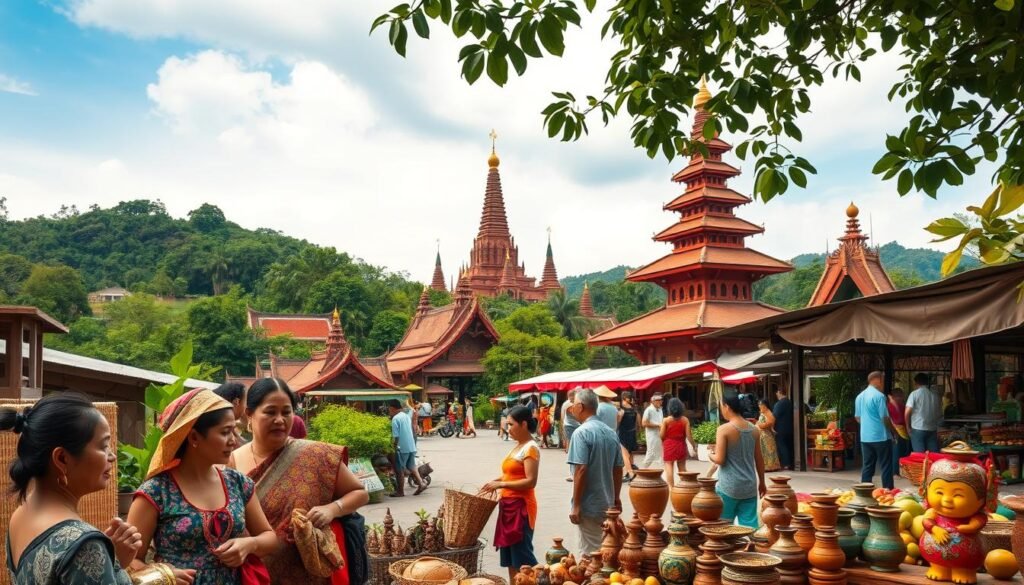
Cultural Respect and Awareness
Cultural sensitivity is key to a respectful and enriching travel experience. Travelers should:
- Learn about local customs and traditions.
- Dress appropriately for temple visits and cultural events.
- Be mindful of photography etiquette, asking permission before taking pictures of people or sacred sites.
By being culturally aware, visitors can foster positive interactions with local people, enhancing their understanding of the culture and contributing to a more meaningful exchange.
Conclusion
The allure of Southeast Asia lies in its ability to surprise and enchant, from bustling cities like Chiang Mai to serene landscapes and idyllic beaches such as those found in Koh Phi Phi. As we conclude our exploration of this vibrant region, it’s clear that Southeast Asia offers an unparalleled richness of experiences that cater to all kinds of travelers.
One of the most significant aspects of traveling through Southeast Asia is the transformative journey it often becomes. It’s not just about ticking off bucket list destinations like Angkor Wat or Siem Reap; it’s about the experiences that change your perspectives and create lifelong memories. The connections made with local people and fellow travelers often become the most treasured aspects of a trip to this region.
The diversity of Southeast Asia is truly astounding, with cultural richness, historical landmarks, and natural beauty on offer. From the spiritual majesty of Angkor Wat at sunrise to the perfect beaches of Koh Phi Phi, there’s something for everyone. Cities like Chiang Mai and Siem Reap offer a deep dive into cultural heritage and history.
It’s a common realization among travelers that no single trip can cover everything this remarkable region has to offer. Many find themselves planning return visits before they’ve even left, drawn by the knowledge that there’s still so much to explore and experience. This is the true charm of Southeast Asia – it invites you to return, promising new discoveries and deeper connections.
As you consider your next travel destination, we hope you’re inspired to take the plunge and begin planning your own Southeast Asia adventure. With the knowledge and insights gained from this guide, you’re well-equipped to create a journey that aligns with your interests, timeline, and travel philosophy. Whether it’s your first visit or your fifth, Southeast Asia is sure to leave an indelible mark on your heart, making you part of a community that cherishes the beauty and diversity of our world.

